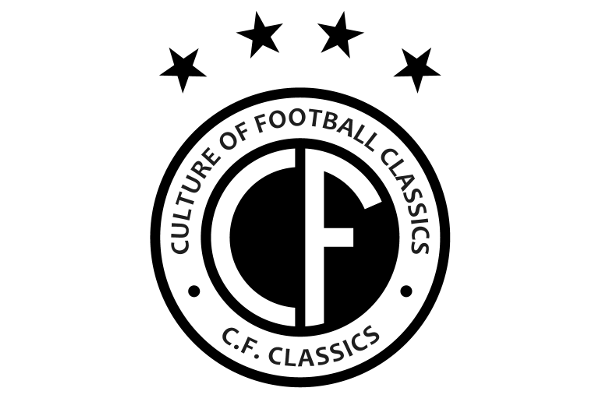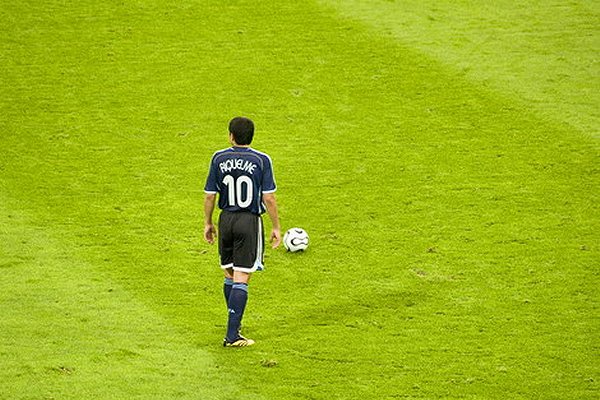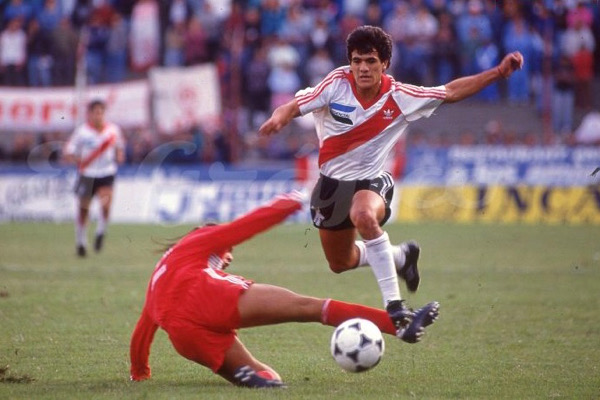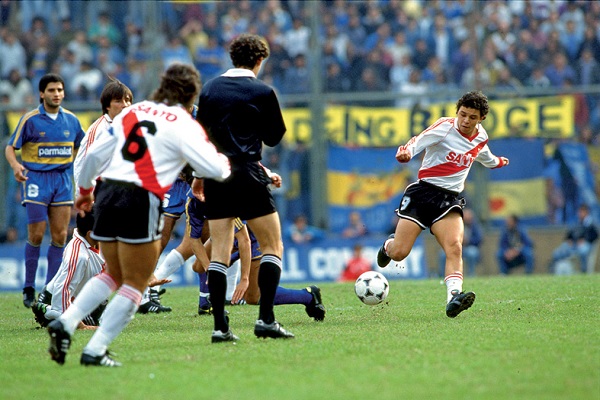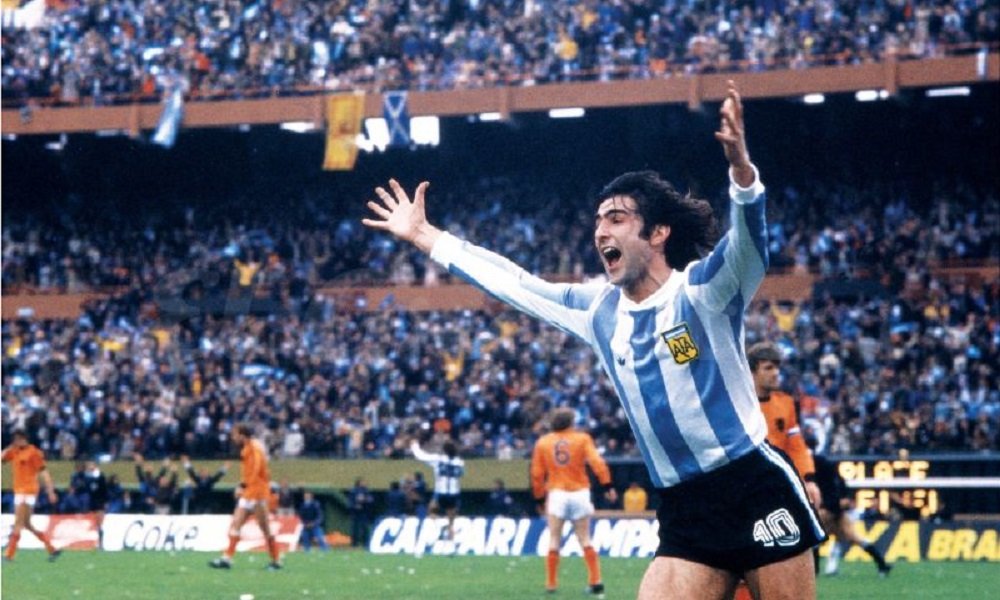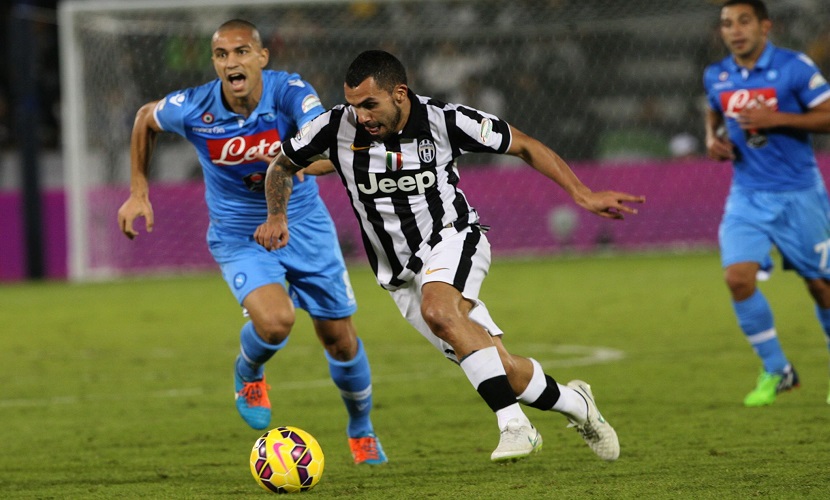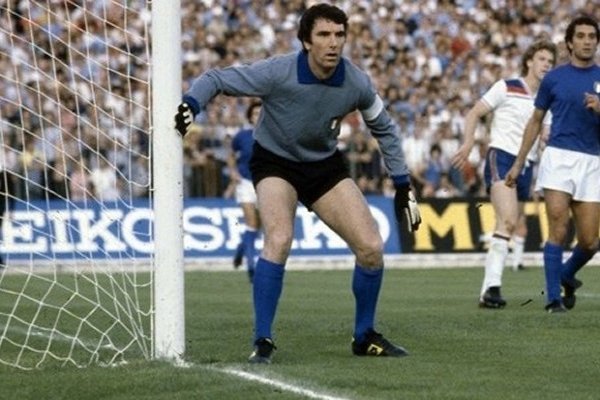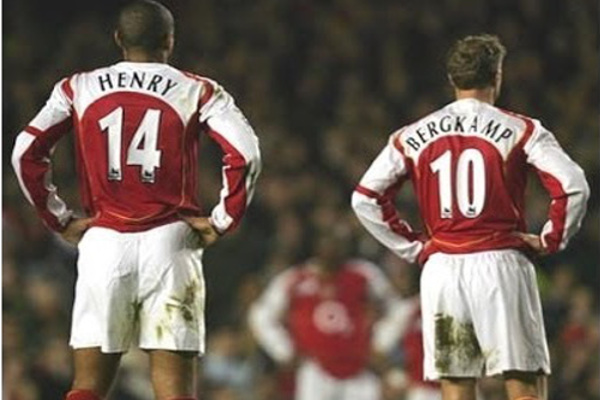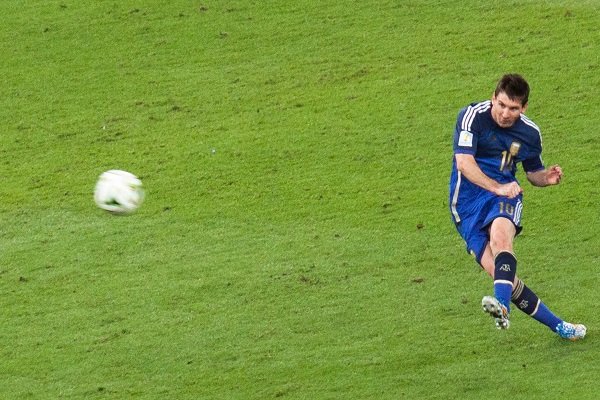The Greatest Number 10s of Argentina
If there's one footballing nation on the planet that has produced a glut of brilliant number 10s, it's Argentina. So, here's our list of the greatest number 10's who've graced either their club sides or the striped shirts of La Albiceleste.
No.1 Diego Maradona (Playing Career: 1976 to 1997)
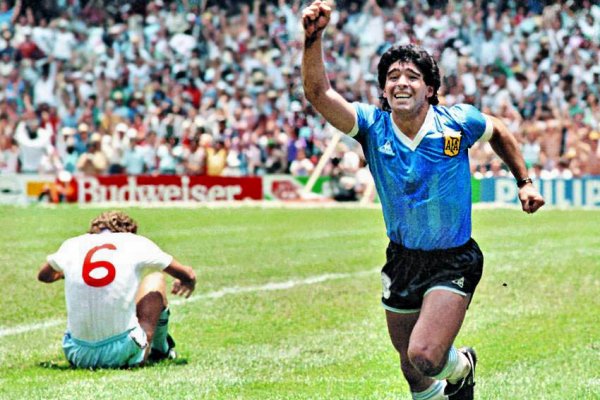
Diego Maradona celebrates his wonder goal against England in 1986.
Photo: Wikimedia Commons / Clarín
Not only do we believe that Diego Maradona is the greatest number 10 in Argentina's history, but we also think that he's the greatest number 10 in football history.
Other players may have scored more goals or won more medals, but no-one else has made us want to watch or play football as Diego Maradona did. Growing up in the late 1970s and early 1980s, we were left open-mouthed at some of the things that Maradona was doing, such as the first time we'd seen a reverse-stepover and a rabona during the match against Switzerland in 1980. Yes, he had plenty of faults and had to fight his own personal demons along the way, but that's what we loved about Maradona. Despite all of the issues and everything that went on, this loveable rogue still captured the imagination and managed to drive his teams on to glory against the odds, not only thanks to his footballing genius but also his leadership, passion and charisma. The famous game against England at Mexico '86 summed Maradona up - mischief with one goal, then genius with the next.
His dribbling and close control were incredible. When he ran with the ball it looked like it had somehow been connected to his foot, whilst his small size and low centre of gravity meant he could twist, turn and accelerate incredibly quickly.
Like Messi, Maradona was extremely left-footed. Some people suggested he was too left-footed, but he seemed to cope okay. When he scored the "Goal of the Century" against England in the 1986 World Cup quarter-final, he didn't use his right foot once, despite running with the ball for over half the length of the pitch down the right-hand side! It was impossible to score such a beautiful goal with only one foot! And then, in the semi-final against Belgium, he scored another incredible solo goal and nearly did exactly the same, but this time he did briefly control the ball with his right foot before setting off and then solely using his left. Two moments of genius on the biggest stage.
As well as being exceedingly dangerous running with the ball, Maradona had tremendous vision and passing, his number of assists were incredible. And if he wasn't creating opportunities for team-mates then he was putting away chances for himself - his goalscoring rate was excellent, whilst his dead-ball skills made him extremely dangerous from free-kicks.
A really dynamic player, and strong too, Maradona's small size was deceiving, as his stocky build and huge thighs, coupled with his tremendous balance, made him incredibly hard to knock off the ball.
As well as all of the technical and physical attributes, Maradona had other qualities too. He was a charismatic and a natural leader. Not only did his talent command instant respect but his personality did too. He also had a drive and a determination about him on the pitch that few other players could match, and this, coupled with his incredible natural footballing ability, is what made Diego Maradona stand out above all of the rest.
No.2 Lionel Messi (Playing Career: 2003 to now)
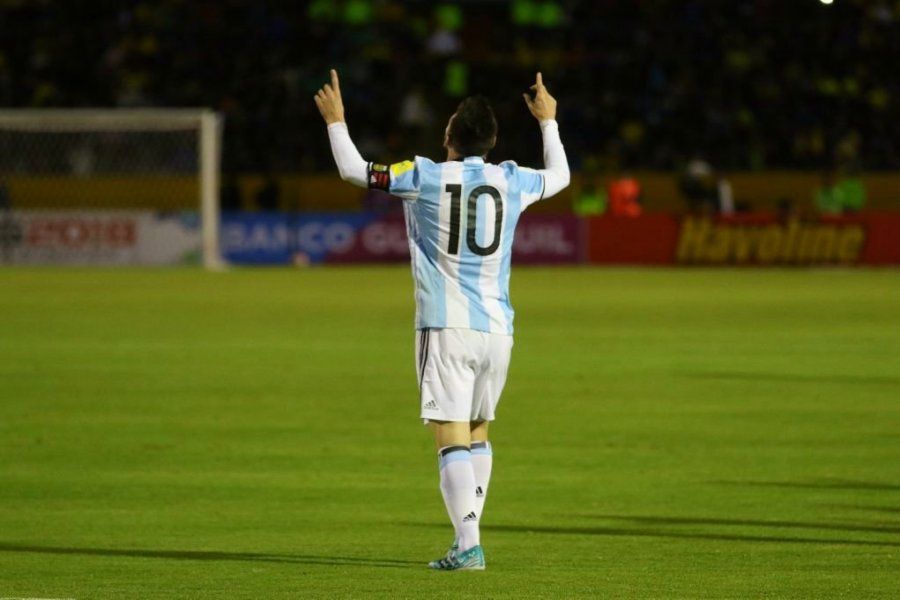
Lionel Messi.
Photo: Wikimedia Commons / Agencia de Noticias ANDES.
Just four years after Maradona's playing career ended, another incredible Argentine talent was unearthed, and he too would be signed by Barcelona. Yet Messi's move to the Nou Camp was a lot different to Maradona's. He'd been with Newell's Old Boys since he was a six-year-old but never got the chance to get near their first team - the Catalan giants snapping him up whilst he was still only thirteen. As a youngster in Argentina, he'd played the classic no.10 enganche role, behind the strikers, whereas in Spain he started his career as a left-winger. It wasn't hard to see why a coach would play Messi on the wing - his dribbling and close control were phenomenal, particularly when running at speed, the ball seemingly stuck to his left foot in the same way it did with Diego Maradona. Indeed, later on, when Pep Guardiola was in charge at Barcelona he said, "Messi is the only player who runs faster with the ball than he does without it".
As Messi's career progressed he was moved to different playing positions by the various managers who coached him; Frank Rijkaard played him on the right-wing so that he could cut inside and shoot with his left foot, Pep Guardiola played him as a false 9, Luis Enrique deployed him deeper as a playmaker. And Ernesto Valverde played him everywhere!
The common factor was that all of his managers realised that Messi was clever enough and talented enough to play in any attacking role. And they all knew that they needed to get him on the ball as often as possible. Messi's game was no longer simply about dribbling - his link-up play, vision and ability to thread a through-ball that no-one else could see, were all just second to none. And to top it all, his goalscoring rate was just off the scale.
Between 2009 and 2019 Messi won the Pichichi award and the European football Golden Shoe award six times out of ten, incredible stats for a player who wasn't always playing as an out-and-out striker. People will inevitably argue the toss about who was better, Lionel Messi or Diego Maradona, but both will go down in history as two of the greatest players to ever wear the number 10 shirt.
No.3 Omar Sivori (Playing Career: 1954 to 1969)
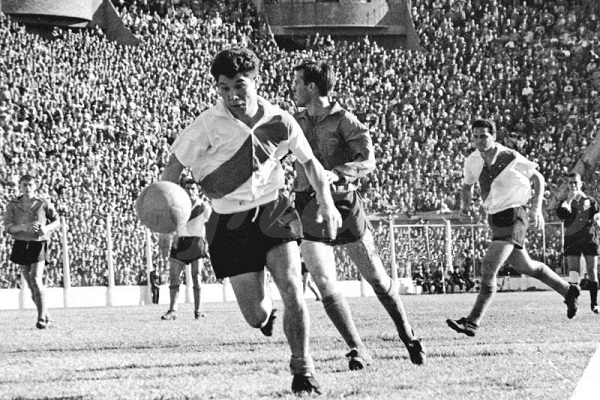
Omar Sívori, socks rolled down, playing for River Plate vs Huracán.
Photo: Wikimedia Commons / El Gráfico
One of the footballing greats of the 1950s and 1960s, Omar Sívori seemed way ahead of his time with some of his skills and tricks, including his trademark tunnel (nutmeg).
Sívori started his career at River Plate and didn't waste any time in showing the club's fans exactly what he was about. Despite his small stature and inexperience, he immediately oozed confidence on the pitch, and there was almost an arrogance about him when he was on the ball. Sívori's dribbling and pace when running with the ball were phenomenal, whilst his flicks, feints and movement highlighted his invention and speed of thought. He'd only just turned twenty when he helped River Plate regain the Argentine title in 1955, before winning the following two titles as well.
In 1957, aged only 21, he was named player of the tournament as Argentina won the South American Championship with a wonderful attacking partnership that was nicknamed "Los Carasucias" (the Angels with Dirty Faces). This deadly partnership featured Sívori alongside Omar Corbatta, Osvaldo Cruz, Humberto Maschio and Antonio Angelillo. Their form alerted big-spending Italian clubs and resulted in Sívori, Maschio and Angelillo being transferred to Juventus, Bologna and Inter respectively. In the case of Sívori, such was his talent that Juventus broke the world record transfer fee to take him to Turin, and the story goes that the money River Plate received for him allowed them to complete the building of a fourth stand at their El Monumental stadium.
In Turin, Sívori soon endeared himself to the Juve faithful with his creativity, skill and passion, forming a formidable attacking trident with Welshman John Charles and club legend Giampiero Boniperti. This earned him another football partnership nickname - "Le Trio Magico" (The Magic Trio). There's a great quote from Giampiero Boniperti about Sivori that gives a real flavour of his playing-style and attitude; "Playing alongside Sivori was pure fun. Charles was the target man, while Omar used the space to put defenders in trouble. He used to play with socks down around his ankles, without any kind of protection, to show he wasn't scared of defenders. He had an incredible winning mentality". He won the Scudetto three times in his first four seasons at Juventus, and his performances earned him the Ballon D'Or award in 1961.
Finally, few players are given a retrospective nickname, but, in articles written about Omar Sivori in recent years, he's been dubbed "the Maradona of the Sixties", which shows exactly just how highly he was rated.
No.4 Juan Román Riquelme (Playing Career: 1996 to 2014)
A true number 10. When Juan Román Riquelme was on song there was simply no better sight in football, the way he linked play and stitched things together with his passing and touches was just a joy to behold.
Riquelme had excellent footwork and ball technique, but it was his passing, vision and creativity for which he was renowned. His ability to dictate the tempo of play was second to none - a rare attribute even amongst the most highly gifted of footballers. Riquelme was a genuine football conductor - orchestrating moves, probing away with clever little passes, noticing angles and openings for his team-mates that other players couldn't.
A Boca Juniors legend, with seven-year stints at both the start and end of his career, Riquelme won every trophy going at La Bombonera, including four Argentinian league titles, three Copa Libertadores and an Intercontinental Cup. He was also named South American Footballer of the Year in 2001 during his first spell with La Boca.
In between his two stints with the Buenos Aires giants, he had an unsuccessful spell at Barcelona, where Dutch coach Louis Van Gaal seemed reluctant to play him, and when he did it was often out of position on the wing. When Barcelona signed Ronaldinho in 2003 it meant they had exceeded the maximum number of foreign players, so Riquelme moved to Villarreal on a two-year loan deal. His time with El Submarino Amarillo proved much more successful than his short spell at the Nou Camp, Riquelme not only topping the assist charts but also achieving his best-ever goalscoring rate. Riquelme's exceptional form helped inspire Villarreal to third place - the club's highest ever La Liga position. Villarreal made the loan deal permanent and they continued to be a surprise package - even reaching the Champions League semi-final in 2006.
Riquelme returned to Boca Juniors in 2007 and his fine form continued - winning the Argentine Footballer of the Year award twice more in 2008 and 2011. He finished his career in 2014 at the club where he'd started his footballing journey as a youngster - Argentinos Juniors.
No.5 Ricardo Bochini (Playing Career: 1972 to 1991)
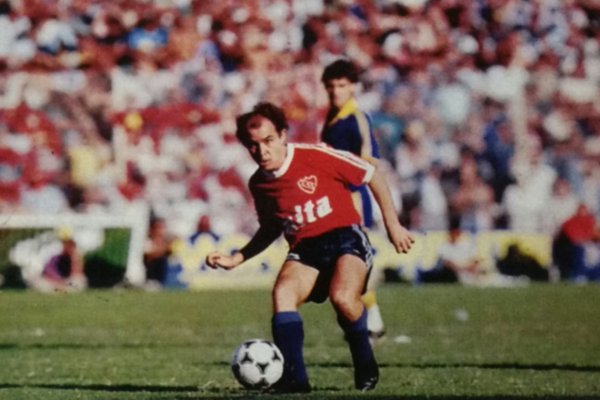
Ricardo Bochine, master of the Pase Bochinesco.
Photo: Wikimedia Commons / El Gráfico
The childhood idol of Diego Maradona, Ricardo Bochini is an Independiente legend, a one-club-man who spent his entire career with the Avellaneda club from 1972 to 1991.
A small attacking midfielder, what Bochini lacked in physical presence he more than made up for with his incredible vision and passing. One of the best playmakers of the 1970s and 1980s, Bochini's assists were crucial as El Rojo claimed four Argentinian league titles, an incredible five Copa Libertadores, and two Intercontinental Cups during his time with the club.
Ricardo Bochini became a master of the killer through-ball, it became his speciality and even had its own terminology named after him - "Pase Bochinesco". Pundits and players would rave about the timing of his passing, he had an intrinsic ability to know when to keep hold of the ball and when, exactly, to release it. In Argentina it was known as La Pausa, the moment when a playmaker pauses slightly as he waits for his target to get into the best position. Ricardo Bochini became renowned for it.
At international level, Bochini received 28 caps for La Albiceleste between 1973 and 1986. One of the main reasons for not gaining more caps was the number of fine attacking midfielders who were fighting it out for the number 10 shirt at the time. The likes of Carlos Babington, Miguel Ángel Brindisi, José Daniel Valencia and Beto Alonso were all competing with Bochini during the 1970s, and then there was the emergence of a certain prodigious young talent called Diego Maradona! Ricardo Bochini did go on to win a World Cup winners medal in 1986, although his pitch time was limited to a five-minute cameo in the semi-final against Belgium.
No.6 Adolfo Pedernera (Playing career: 1935 to 1955)
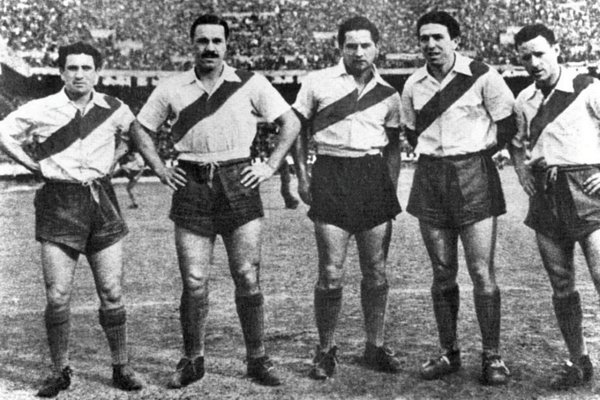
Adolfo Pedernera (3rd from the left) as part of River Plate's legendary La Máquina line-up of 1941.
Photo: Wikimedia Commons / Clarín
Adolfo Pedernera is a legendary figure of Argentinian football and widely accepted as one of the greatest players of the 1940s. Nicknamed "El Maestro" (The Teacher), Pedernera was best known for his phenomenal passing and intelligent play.
Operating mainly as an inside forward, he was a key part of the fabled River Plate team of the 1940s that were known as La Máquina (Spanish for "The Machine"), winning five Argentine titles alongside other great attacking talents such as Ángel Labruna and José Manuel Moreno. Adolfo Pedernera and his La Máquina teammates were skilful, adaptable and intelligent enough to be able to interchange positions, one of the earliest examples of a team adopting a dynamic Total Football style of play.
At international level, Pedernera was part of a fantastic Argentinian side that won three Copa América titles in 1941, 1945 and 1946. Unfortunately, the Second World War would mean that neither Pedernera, nor this great Argentinian team of the 1940s, would get to compete in the World Cup.
After leaving River Plate for short spells with Atlanta and Huracán, Pedernera enjoyed a great career swansong in Colombia with Millonarios. Argentinian players were heading to the north of the continent as a result of a players' strike in 1948, and Pedernera signed up with fellow countrymen Alfredo Di Stéfano and Néstor Rossi. Pedernera would win the league title four years out of five during his time with Millonarios, and this team would also have its own special nickname... Ballet Azul (the Blue Ballet).
Finally, if there's any doubt about Adolfo Pedernera's talent then the great Di Stéfano himself was quoted as saying that Pedernera was the best player he'd ever seen. High praise indeed.
No.7 Pablo Aimar (Playing Career: 1996 to 2015)
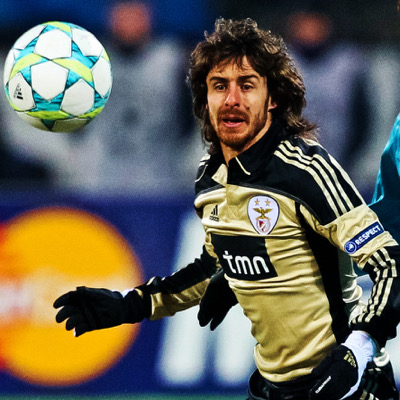
Pablo Aimar at Benfica.
Photo: Wikimedia Commons
Pablo Aimar was one of two teenage sensations at River Plate in the late 1990s, the other one being Javier Saviola. Both were ridiculously talented, oozing skill and class, and both were immediately added to the ever-growing list of the next Maradona. However, whilst Saviola was phenomenal operating as a second-striker, it was Aimar's vision, invention and passing that made him a classic Argentinian number 10, attributes that would see him become one of the finest attacking midfielders of the late 1990s and 2000s.
Aimar first came to global attention in 1997 when he was awarded the Bronze Ball as part of the Argentinian team that won the U-20 World Cup, Having won three titles with River Plate, Spanish side Valencia paid a club-record transfer fee of 24m euros to take the 20-year-old to the Mestalla. Aimar began his La Liga career impressively, his assists and goals proving vital as Valencia won the Spanish title in 2002, their first La Liga triumph in over 30 years. It's no surprise that he became a huge crowd favourite during his time at the Mestalla - his elegant playmaking style was a joy to watch. He was flamboyant too - a great dribbler who could quickly beat a couple of opponents to make something out of nothing. Pablo Aimar was the sort of player that fans would happily pay to watch.
Unfortunately, having claimed another La Liga winners medal in 2004, Aimar started to pick up some injuries, and it was a problem that would plague him throughout the remainder of his career. After five years at Valencia, Aimar moved to Zaragoza in 2006 and had two contrasting seasons with Los Maños; his assists helped the club reach a hugely respectable sixth place at the end of his first season, but the injuries returned to haunt him in the second season and Zaragoza were relegated.
Despite the injuries, European clubs were still interested in taking a gamble on signing Aimar because they knew that on his day he was as a talented as any player in the world. Benfica did just that in 2008. The Lisbon giants had only won one league title in thirteen years and were looking to build something to try and break Porto's dominance. An injury-hit start to Aimar's first season didn't bode well for the Benfiquistas, but the following season saw new manager Jorge Jesus put together a fantastic attacking quartet that would take the Portuguese league by storm. Alongside Paraguayan forward Óscar Cardozo and 21-year-old winger Ángel Di María, Aimar was also joined by his old River Plate team-mate Javier Saviola. With Aimar and Saviola forming an almost telepathic partnership behind Cardozo, Benfica romped to the league title, scoring 78 goals along the way. Aimar would have five years at Benfica, becoming a huge fan favourite there despite the ongoing injury problems. His career would end in 2015 with one final substitute appearance for the club where his professional career had started, River Plate.
Pablo Aimar was a beautiful footballer, one of our favourites in the 2000s, and, if it hadn't have been for the injuries, who knows how great he could have been.
No.8 Antonio Sastre (Playing Career: 1931 to 1947)
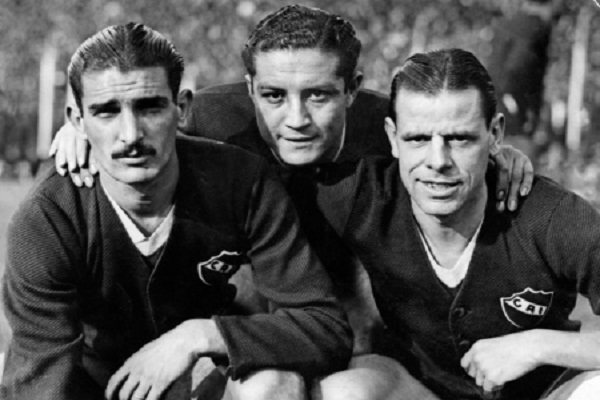
Antonio Sastre (on the right) with Indepentiente forward partners Vicente de la Mata and Arsenio Erico.
Photo: Wikimedia Commons / El Gráfico
Antonio Sastre was a rare breed indeed - a pre-war playmaker, one of the first of their kind, some even say that he invented the modern playmaking style in Argentina. He would become one of the biggest influences on future players of his ilk. Sastre was also known as one of the first footballers who could adapt to play almost any position on the pitch, thanks mainly to his coolness on the ball and his tactical intelligence. Despite his flexibility, his intelligence and skill on the ball meant that he was best-suited playing along the front line, and he was most dangerous when dropping behind an out-and-out forward and creating chances.
Sastre started his senior career with Independiente and stayed with El Rojo for eleven years, much of it spent forming a formidable attacking trident alongside Vicente de la Mata and Arsenio Erico. Erico had a phenomenal strike-rate, and De la Mata wasn't far behind, but it was Sastre who was the creator, dropping deep to pick up the ball and directing things for his team-mates. Sastre's form would help inspire Independiente to two league titles in 1938 and 1939, breaking the dominance of River Plate.
In 1942, now aged 31, Sastre left Independiente and moved to Brazilian club São Paulo, where he would enjoy a brilliant swansong to his career, forming another fantastic partnership, this time with Leonidas, the World Cup Golden Boot winner from the 1938 tournament. São Paulo hadn't won a championship since 1931 and Antonio Sastre was influential in helping them to win three Paulista championships.
Unfortunately, Sastre never got the chance to play in the World Cup - the 1942 and 1946 tournaments were cancelled because of the Second World War, and Argentina boycotted the 1938 World Cup in France in response to the decision to hold a second successive World Cup in Europe. However, Sastre did win the Copa America three times. Perhaps the greatest accolade of Antonio Sastre's career though, was in 1980, when he was awarded his country's Diploma of Merit as one of the top five players in Argentina's history alongside Diego Maradona, Alfredo Di Stefano, Adolfo Pedernera and José Manuel Moreno.
No.9 José Manuel Moreno (Playing Career: 1935 to 1961)
Another member of the River Plate team known as La Máquina, and another player blessed with great vision and technique, José Manuel Moreno started his career in 1935 with River Plate and would go on to become one of the most revered South American footballers of the twentieth century. Operating mainly as an inside-right or attacking midfielder, Moreno linked up brilliantly with the likes of Adolfo Pedernera and Ángel Labruna, winning five championship titles during his first nine years with "Los Millonarios",
In 1944, Moreno was transferred to Mexican Primera División club España, where he formed a great partnership with another new signing, Spanish striker Isidro Lángara, and together they inspired España to the title in 1945-46. It was during this spell that Moreno earned his nickname "El Charro", the name of the traditional Mexican cowboy.
He returned to River Plate in 1946, linking up with a new star of Argentinian football, Alfredo Di Stéfano, and adding another title to his growing list of honours. The Argentinian players' strike of the late 1940s saw José Manuel Moreno head off abroad again, this time to Universidad Católica in Chile, winning yet another title. Finally, in 1955, at the age of 39, he became the first footballer to win league titles in four countries, as he rolled back the years to help Independiente Medellín win the Colombian title. Not bad for a player who had a reputation for drinking, smoking and not taking training seriously enough!
No.10 Beto Alonso (Playing Career: 1970 to 1987)
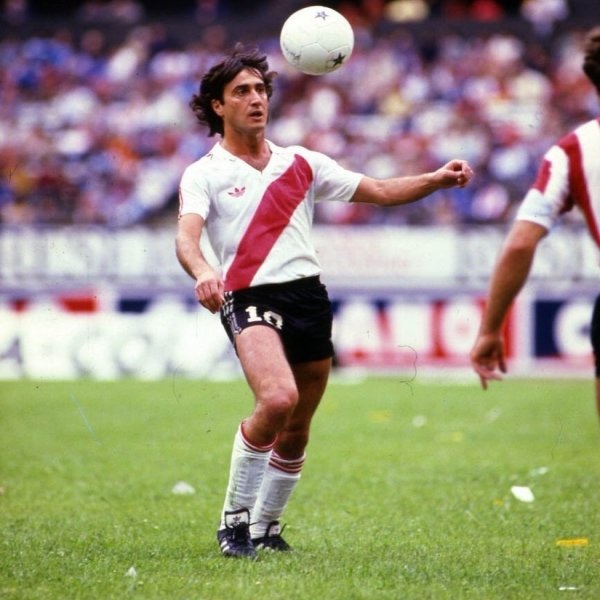
Beto Alonso, River Plate 1984.
Photo: Wikimedia Commons / El Gráfico
Widely known as Beto Alonso, rather than Norberto, he's one of River Plate's most iconic footballers having enjoyed fourteen seasons during three different spells at El Monumental from the early 1970s to the mid-1980s.
An attacking midfielder, Alonso naturally had great feet and an eye for a killer-pass, whilst his goalscoring rate was tremendous for a number 10 - he's fifth on the all-time scorers list for Los Millonarios with 158 goals.
Along with the likes of Daniel Passarella and Roberto Perfumo, Beto Alonso was one of the key players as River Plate ended an 18-year wait for an Argentinian league title in 1975, winning both the Metropolitano and Nacional titles.
Beto Alonso picked up a World Cup winner's medal in 1978 after Argentina's victory on home soil, although his game time was limited to three substitute appearances as head coach César Luis Menotti gave Mario Kempes the nod in the attacking midfielder berth.
After a couple of seasons with Vélez Sársfield in the early 1980s, El Beto returned to River Plate for the third time in 1983 and would enjoy a great finale to his career. In one of his best-ever seasons, River Plate beat Colombian side América de Cali to win the 1986 Copa Libertadores, Alonso scoring in the first leg as they won 3:1 on aggregate, before picking up another winners medal six weeks later in the Intercontinental Cup after they beat European Cup holders Steaua Bucarest 1:0 in Tokyo. It was a fitting way to end a great career as Beto Alonso would then retire in 1987.
No.11 Ariel Ortega (Playing Career: 1991 to 2012)
Nicknamed "El Burrito" (the Little Donkey), Ariel Ortega was anything but. Ortega started his professional career with Daniel Passarella's River Plate in 1991 and during the seasons that followed he'd play alongside the other talented youngsters of that period, Marcelo Gallardo and Hernán Crespo, as well as legendary River Plate old-boys Enzo Francescoli and Ramón Díaz.
With his dribbling skills, vision, arrogance on the ball and dynamic style, it wasn't long before the inevitable comparisons were being made with Diego Maradona, and Ortega was seen as a likely heir to the number 10 throne as he continued to master the enganche role - he even had the fiery temperament to go with it.
Having won four Argentina football league winners titles and a Copa Libertadores within five years at River Plate, Ortega had become a huge crowd favourite at El Monumental. However, his success hadn't gone unnoticed in Europe, so it was no surprise when Spanish side Valencia made a move for him in 1997. Things didn't go well at the Mestella though, Ortega struggled to hold down a regular place under coach Claudio Ranieri as the Italian's tactics didn't seem to suit him.
France 1998 saw Ariel Ortega handed Argentina's fabled number 10 shirt - the first time since 1978 that anyone other than Maradona had worn it at a World Cup. Pulling the strings as the side's attacking midfielder, Ortega had a great start to the tournament, playing in every game and scoring a couple of goals as they cruised through the opening group and then beat England in an epic encounter at Saint-Étienne's ground. However, things turned sour for Ortega in the quarter-final clash with the Netherlands when he was sent off for headbutting Edwin van der Sar.
After the tournament, Ortega moved to Sampdoria to replace World Cup team-mate Juan Sebastián Verón. However, despite scoring a reasonable 8 goals in 27 Serie A appearances, the season turned into a disaster, with Luciano Spalletti being replaced at the helm by David Platt halfway through the season and Platt, for some reason, preferring to play on-loan Lee Sharpe instead of Ariel Ortega. The season ended with Samp finishing third from bottom and being relegated to Serie B.
Ortega had done enough to persuade high-flying Parma to buy him though, and yet again he replaced Verón, who was Lazio-bound. Despite joining up again with former River Plate team-mate Hernán Crespo, Ortega struggled, only managing three goals and a handful of assists, so it was no surprise when River Plate manager Américo Gallego announced in 2000 that they'd struck a deal to bring him back home to Argentina. It turned out to be one of the best decisions of Ariel Ortega's career as he became a man reborn at El Monumental thanks to an array of attacking talent that was the envy of Argentina - Ortega playing alongside upcoming stars Javier Saviola, Pablo Aimar and Juan Pablo Ángel in a formidable partnership that was nicknamed "Los Cuatro Fantásticos" (the Fantastic Four).
With Ariel Ortega back to full form, Europe came calling once again in 2002 when Turkish giants Fenerbahçe announced his signing. El Burrito couldn't settle there at all though, and, at the start of 2003, he failed to return to Turkey after international duty, which resulted in a ban from football until the end of the year.
After serving out his suspension, Ariel Ortega returned to Argentina once more in 2004, signing for Newell's Old Boys. Ortega had two fine years there, helping La Lepra win the 2004 Apertura, their first Argentinian title since 1992. Ortega's form persuaded River Plate to sign him for a third time, however, despite winning the Clausura title in 2008, his final spell there was a stop-start affair. As with so many other maverick footballing talents, Ariel Ortega had a self-destructive side to him, and his off-field struggles with alcohol started to affect his performances during his final six-year spell there.
In 2013, River Plate arranged a farewell match for him at El Monumental. It was a fitting end for a player who, despite showing flashes of his undoubted talent during his time in Europe, was clearly far happier playing back in his homeland for a club where he'd become an icon amongst their fans. Whilst Diego Maradona and Juan Román Riquelme had become legends at rivals Boca Juniors, Ariel Ortega had become a legend at El Monumental with River Plate.
No.12 Marcelo Gallardo (Playing Career: 1993 to 2011)
Having played second fiddle to the likes of Ariel Ortega and Enzo Francescoli in that fine River Plate team of the mid-1990s, Marcelo Gallardo finally came into his own as the team's playmaker in the late 1990s. He was capable of great moments of skill and had terrific ball control, but Gallardo's finest attributes were undoubtedly his passing, vision, and intelligence on the ball. He was one of those rare players who could dictate his team's tempo, stitching all the play together and then splitting the opposition's defence with a killer-pass. It was this creativity that saw him operate mainly as an attacking midfielder or occasionally a central midfielder.
Having won five Argentinian league titles and a Copa Libertadores winners medal, Marcelo Gallardo moved to Europe in 1999, signing for French club Monaco. He joined an extremely talented side that included the likes of Fabien Barthez, Rafael Márquez, Philippe Christanval, Ludovic Giuly, David Trezeguet and Marco Simone. Gallardo formed a particularly good partnership with Giuly, the French winger combining brilliantly with the little Argentinian in his first season. And what a season it was too, free-scoring Monaco romping to the title ahead of Paris Saint-Germain, whilst Marcelo Gallardo was named the Ligue 1 Player of the Year.
Having hit the heights so quickly, things then went rapidly downhill for Gallardo and Monaco in the following seasons. Whilst Gallardo didn't have a bad season, the team struggled to live up to their new tag as title favourites and they failed to retain their title, finishing in a lowly 11th position. The slump resulted in manager Claude Puel being replaced with Didier Deschamps. Unfortunately, Gallardo didn't seem to fit into the new manager's plans and River Plate were able to agree on a deal to bring him back to El Monumental. He was soon winning titles again, as he captained the side to the 2004 Clausura. However, in 2006 the new Los Millonaros manager, Daniel Passarella, was starting to prefer Fernando Belluschi, prompting interest from both Marseille and Paris Saint-Germain to bring Marcelo Gallardo back to Ligue 1. He opted for the latter and moved to the Parc des Princes at the start of 2007, now aged 31. He would only stay for another year in France though, before signing for D.C. United at the start of 2008. Unfortunately, he picked up a hernia injury and his time in the MLS was limited to only 15 appearances. So, at the start of 2009, he returned to River Plate for the third time and had a couple more seasons at El Monumental before finishing his career over the border with Nacional, picking up a final career title in Uruguay.
No.13 Alfredo Di Stéfano (Playing Career: 1945 to 1966)
Often referred to as the most complete footballer in the history of the game, and for good reason too, because Alfredo Di Stéfano could literally play anywhere. Looking at his incredible goalscoring-rate, it would be fair to think that he was an out-and-out striker, but he was so much more than that. He would drop back to positions all over the pitch to get on the ball, and then conduct the play from there, stitching all the play together with either some subtle link-up, a defence-splitting pass, or a quick change of pace to burst forward. Not only would he drop back to get the ball, but he'd also drop back to cover team-mates if they'd gone forward with the ball. His stamina and energy were relentless.
Di Stéfano started his career at River Plate in 1945, a great era for the club that featured an incredible group of players nicknamed La Máquina (the Machine). He'd win a couple of titles in Buenos Aires before heading to Colombian club Millonarios in 1949 because of a players-strike in Argentina. It was his move to Spain that would earn him worldwide fame though, achieving unprecedented success at Real Madrid by winning five European Cup in a row, eight league titles, the inaugural Intercontinental Cup and, on a personal level, two Ballon D'Or awards. He was capped by not one national team, or even two, but three, representing each of the nations whose leagues he'd played in: Argentina, Colombia and Spain.
There's a great quote by Bobby Charlton from the 1957 European Cup Semi-Final between Real Madrid and Manchester United, and it completely captures what Alfredo Di Stéfano was all about:
"I couldn't take my eyes off this midfield player and I thought, who on earth is that? He ran the whole show and had the ball almost all of the time. They beat us 3-1 and he dictated the whole game. I'd never seen anything like it before - watching someone influence the entire match. Everything went through him. The goalkeeper gave it to him. Full-backs were giving it to him. The midfield players were linking up with him, and the forwards were looking for him. Wherever he was on the field he was in a position to take the ball and influence the play. I was just sitting there, watching, thinking it was the best thing I had ever seen. And this was when Di Stefano was thirty. What must he have been like in his younger days?"
No.14 Mario Kempes (Playing Career: 1970 to 1994)
Okay, stick with us here - we know that Kempes wasn't a traditional number 10, he was often played as more of an out-and-out goalscoring forward. However, he did wear number 10 in the 1978 World Cup, albeit only because he was the 10th name in the squad - the numbers were done alphabetically, and he was actually played as an attacking midfielder by César Luis Menotti for the majority of the tournament, with Leopoldo Luque playing up front as a lone striker. It worked incredibly well. Kempes loved to run at defenders, so getting the ball a bit deeper, and having a bit more space to start the attacks from, wasn't a problem for him. He did move to centre-forward in the second-round match against Poland, before reverting to an attacking midfielder for the remaining matches and becoming the standout player of the whole tournament - winning the Golden Boot with 6 goals.
At club level, Kempes spent seven seasons in La Liga with Valencia during two spells there in the 1970s and 80s, whilst in Argentina he played for Instituto, Rosario Central and River Plate.
No.15 Carlos Tévez (Playing Career: 2001 to 2020)
A stocky, tenacious, hard-working, dynamic forward, Carlos Tevez was a real handful to play against. Having started his career with Boca Juniors in 2001, he took the unusual step of moving to the Brazilian league (with Corinthians) before heading to Europe. When he did arrive in Europe he caused another surprise, signing for an English team rather than for a club in one of the leagues that most Argentine footballers traditionally transferred to, Italy or Spain. Having quickly made a name for himself at West Ham United, Tevez then moved to Manchester United for a couple of seasons before switching across the city to rivals Manchester City.
Tevez certainly racked up a fine list of honours during his playing career abroad. As well as winning three English league titles during his time in Manchester (two with United, one with City), he also won two Serie A titles with Juventus and a Brazilian league title with Corinthians. Add to that all of his trophies from his three spells with Boca Juniors, including five Argentina football league titles, a Copa Libertadores winners medal and an Intercontinental Cup winners medal, and you have one pretty successful football career.
You can find more information and detail on all of these great Argentinian number 10s on our football player profiles section, and please feel free to get in touch with us if we've overlooked one of your favourites.
Tweet
